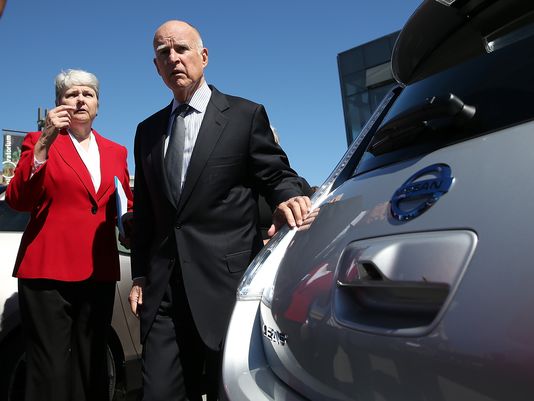 Today California inaugurates a new governor, Gavin Newsom, and says goodbye to four-term governor Jerry Brown. Governor Brown made climate change a central issue in his last two terms. Here are (to my mind) his top achievements on this issue:
Today California inaugurates a new governor, Gavin Newsom, and says goodbye to four-term governor Jerry Brown. Governor Brown made climate change a central issue in his last two terms. Here are (to my mind) his top achievements on this issue:
- Setting and signing clean energy goals: Some may take it for granted now, but when Governor Brown came into office, solar panel prices were almost 80% higher than they are today. By setting goals like 50% renewable energy by 2030 and now 100% carbon-free electricity by 2045, and then signing legislation to codify them, Governor Brown helped boost a global market for clean power that has dramatically reduced prices and helped California achieve its 2020 climate goals four years early. The progress also enabled countries and states around the world to take advantage of lower-cost renewable energy.
- Bolstering a low-level carbon tax through cap-and-trade: Governor Schwarzenegger originally launched the state’s cap-and-trade program before Gov. Brown took office, but Brown seized the mantle and put his political capital behind extending it through 2030 with a two-thirds legislative vote. While the program has its flaws, its minimum price floor guarantees something that approximates a low-level carbon tax, which produces billions of dollars for climate investments, from weatherization to high speed rail. It also strengthened the state’s image as a global climate leader in time for the 2015 Paris accord.
- Forging global climate cooperation: Gov. Brown’s senior advisor Ken Alex hatched the idea in early 2015 of a global pact of subnationals (cities and states) that wanted to take more ambitious action on climate change than their national governments. The movement took off, with California and the German state of Baden-Württemberg in the lead as founding members. Today it boasts a coalition of 220 governments who represent over 1.3 billion people and 43% of the global economy. It successfully pushed international climate negotiators to take stronger action on climate in 2015 and continues to be an important political and problem-solving force for climate on the world stage.
- Boosting zero-emission transportation: Much like renewable energy, zero-emission vehicles like battery electrics were very expensive when Governor Brown took office. But thanks in part to his leadership to boost incentives and mandates for these vehicles and the batteries that supply them, as well as the charging infrastructure to fuel them, battery prices have plummeted since he took office. This technological advancement has enabled longer-range, more affordable electric vehicles like the Chevy Bolt EV and Tesla Model 3. California is now home to roughly 50% of the plug-in electric vehicles nationwide, with home-state Tesla selling the majority of those vehicles in 2018. Progress on this technology is crucial, as climate policy will fail if we don’t reduce emissions from the transportation sector more generally.
- Setting long-term carbon neutrality goals: Governor Brown’s 2018 executive order calls for California to achieve carbon neutrality by 2045. It’s a bold goal that the legislature may soon codify, and it’s needed according to climate science. What it means is that the state will seek to offset whatever emissions it can’t reduce by 2045, possibly through technologies or practices that drawdown carbon from the atmosphere and sequester it in (or on) the ground. That type of technology will be an important next phase for climate action, as we seek to repair the damage done from historic emissions.
- Improving climate communication: Governor Brown never shied away from discussing climate change and made it a point to tell audiences about the dire threat and changes required to address it. At a time when political media generally stays away from climate coverage, Brown forced the issue to educate the public about the need for action. The most recent highlight was the September 2018 Global Climate Action Summit in San Francisco, which attracted major celebrities, activists, world leaders and media coverage for the issue.
Yet with all of these successes, Governor Brown leaves with one giant piece of unfinished business on climate change: achieving climate-friendly land use. In short, the governor was unable to ensure that most new housing and other real estate development in the state happen in the most climate-friendly locations (near transit and in existing urbanized areas) and types (i.e. multifamily, compact development). As a result, driving miles in the state are way up, as are emissions from transportation.
To be sure, the governor signed some helpful (though small-bore) legislation to address the challenge, and he achieved some reforms to the environmental review process that can hold up meritorious projects. But it was ultimately not nearly enough. It will therefore be up to the next governor and legislature to chip away at the local control that has has stymied this climate imperative. Increased sprawl and driving miles will otherwise undermine our emission reductions in other sectors.
On balance though, it’s hard to imagine California (or the world) having a more effective, focused and sincere advocate for action on climate change. For that reason, Governor Brown will be missed, though I look forward to seeing what he will accomplish out of office as a private citizen. He has left some big shoes for Gavin Newsom to fill — and a path forward on climate change for the rest of us to follow.


